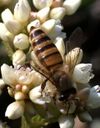Bee
This is an article about the stinging bee found in trees. For the less harmful variety found around flowers, please see honeybee.
- "I got stung by BEES! Ow! Ow ow ow ow ow!" —Wild World
- "I caught a bee! Bzz! Bzz! Bzz! Glad I didn't get stung!" —City Folk
| ||||||
| 200px | ||||||
| Real-world info | ||||||
|---|---|---|---|---|---|---|
| Name: Apis cerana japonica Family: Apidae - Bees | ||||||
| Main appearances | ||||||
|
| ||||||
| Other appearances | ||||||
Names in other languages
Unknown
Unknown Unknown Unknown
Unknown
Unknown Unknown Unknown
Unknown Unknown Unknown Unknown | ||||||
Bees are in every game. They are an insect in the Animal Crossing series that fall, in bee hives, from shaken trees. Bees chase the player that shakes the tree (the reaction beforehand is one of shock) until they either take cover in a building, catch the bee, or get stung. If stung, the player's left eye will swell up. They are worth 2,500 Bells in Animal Crossing City Folk and 4,500 Bells in all of the other games. Five bee hives are generated every day, but don't fall when the gate is open.
The Player will require medicine or can simply save and end the game to be healed. Villagers will remark on a stung player's appearance if they have been stung, some reacting in fright (like Marina); some like Portia, chiding the Player for that attack (adding insult to injury); while cranky villagers outright laugh at the player in amusement. If a bee hive falls from a tree and the player goes to talk to a villager, they will notice the bees in the air and say something in fear. i.e., "Get away from me!"
Donating to the Museum
In Wild World
Blathers will comment on your donation as follows:
"I once thought that its stinger was a bee's lone defense, but... ...I've recently heard that they also possess terribly replusive breath! Of course, the gent who told me this was a bit of a rabit liar, but still! I would heartly endorse the following action if you see another: FLEE LIKE MAD! Stingers and bad breath, honestly! What monstrous little beasties..."
In City Folk
Blathers will comment on your donation as follows:
"It can be quite dangerous to receive a large dose of bee venom-- for example, by being stung. That said, did you know that same substance is actually used in some women's perfumes? Indeed! A potent venom and a potent perfume... Which do you suppose is more devastating, wot?"
The bee can be found flying from tree to tree along the back wall of the museum's insect exhibit.
Encyclopedia Information
Wild World
''These dangerous bugs are black and yellow."
|
Further Information
Apis cerana japonica, the Asiatic honey bee, is a hardy species of bee that originates from South-Eastern Asia. It is used commercially for its honey, despite having a smaller yield than its European counterpart, Apis mellifera. Mellifera has, however, been subject to selective breeding for many centuries, greatly increasing honey output over the years.
Cerana can survive at temperatures of as low as -0.1ºC and heights of up to 3,500 meters.
An interesting form of defense in the case of the Asiatic honey bee against a specific predator, the Japanese giant hornet, involves swarming around the hornet. This raises the hornet's temperature, overheating and subsequently killing it.
| Bugs | ||||||||||||||||||||||||||
|---|---|---|---|---|---|---|---|---|---|---|---|---|---|---|---|---|---|---|---|---|---|---|---|---|---|---|
| ||||||||||||||||||||||||||
